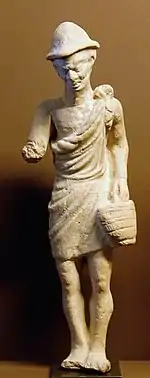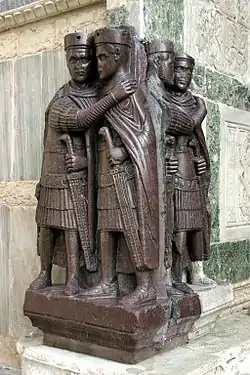Pileus (hat)
The pileus (Ancient Greek: πῖλος, pîlos; also pilleus or pilleum in Latin) was a brimless, felt cap worn in Ancient Greece, Etruria, Illyria, Pannonia and surrounding regions,[1][2] later also introduced in Ancient Rome.[3] In the 5th century BC a bronze version began to appear in Ancient Greece and it became a popular infantry helmet. It occasionally had a horsehair crest.[4] The Greek πιλίδιον (pilidion) and Latin pilleolus were smaller versions, similar to a skullcap. The plis worn today in Albania and Kosovo is thought to originate from a similar felt cap worn by the ancient Illyrians.

History

Greece
The pilos (Greek: πῖλος, felt[5]) was a typical conical hat in Ancient Greece among travelers, workmen and sailors, though sometimes a low, broad-rimmed version was also preferred, known as petasos.[6] It could be made of felt or leather. Pilos caps often identify the mythical twins, or Dioscuri, Castor and Pollux, as represented in sculptures, bas-reliefs and on ancient ceramics. Their caps were supposedly the remnants of the egg from which they hatched.[7] The pilos appears on votive figurines of boys at the sanctuary of the Cabeiri at Thebes, the Cabeirion.[8]
In warfare, the pilos type helmet was often worn by the peltast light infantry, in conjunction with the exomis, but it was also worn by the heavy infantry.
The pilos helmet was made of bronze in the same shape as the pilos which was presumably sometimes worn under the helmet for comfort, giving rise to the helmet's conical shape.[9] Some historians theorize that the pilos helmet had widespread adoption in some Greek cities such as Sparta,[10][2] however, there is no primary historical source or any archeological evidence that would suggest that Sparta or any other Greek state would have used the helmet in a standardized fashion for their armies. What led historians to believe that the helmet was widespread in places such as Sparta was, amongst other reasons, the supposed advancement of battlefield tactics that required that infantry have full vision and mobility.[10] However, many other types of Greek helmet offered similar designs to the pilos when it came to visibility, such as the konos or the chalcidian helmets, and the idea that Sparta widely adopted the pilos helmet, or any type of helmet in a standard fashion, is based purely on speculation, since any surviving records of classical historians such as Herodotus or Xenophon never gave such an account of a precise type of widespread equipment or helmet the Greeks wore at any point in time.
Illyria
The plis, an Albanian felt cap, originated from a similar felt cap worn by the Illyrians.[11][12][13]
Rome

In Ancient Rome, a slave was freed in a ceremony in which a praetor touched the slave with a rod called a vindicta and pronounced him to be free. The slave's head was shaved and a pileus was placed upon it. Both the vindicta and the cap were considered symbols of Libertas, the goddess representing liberty.[14] This was a form of extra-legal manumission (the manumissio minus justa) considered less legally sound than manumission in a court of law.
One 19th century dictionary of classical antiquity states that, "Among the Romans the cap of felt was the emblem of liberty. When a slave obtained his freedom he had his head shaved, and wore instead of his hair an undyed pileus."[15] Hence the phrase servos ad pileum vocare is a summons to liberty, by which slaves were frequently called upon to take up arms with a promise of liberty (Liv. XXIV.32). The figure of Liberty on some of the coins of Antoninus Pius, struck A.D. 145, holds this cap in the right hand.[16]
In the period of the Tetrarchy and subsequently a distinctive type of round, brimless hat known as the Pannonian cap (pileus pannonicus) was worn as part of a Roman soldier's costume, though it also seems to have been worn by non-military bureaucrats. It was flat topped and resembled the more recent 'pillbox hat'.[17][1]
Gallery
 Ancient Greek pilos type helmet, 450–425 BC
Ancient Greek pilos type helmet, 450–425 BC Odysseus wearing the pilos. Ancient Greek red-figure situla from Apulia, ca. 360 BC, Museo Nazionale Archaeologico, Naples
Odysseus wearing the pilos. Ancient Greek red-figure situla from Apulia, ca. 360 BC, Museo Nazionale Archaeologico, Naples

 The pileus particularly identifies the Dioscuri (here on a colossal statue of late Antiquity in the Campidoglio, Rome).
The pileus particularly identifies the Dioscuri (here on a colossal statue of late Antiquity in the Campidoglio, Rome). John Wilkes depicted by Hogarth with the cap of Liberty on a pole, as it was sometimes carried in public demonstrations during the 18th century
John Wilkes depicted by Hogarth with the cap of Liberty on a pole, as it was sometimes carried in public demonstrations during the 18th century Ancient Greek helmets. Top line, from left to right: Illyrian type helmet, Corinthian helmet. Bottom line, from left to right: Phrygian type helmet, Pileus helmet with an olive branch ornament, Chalcidian helmet. Staatliche Antikensammlungen
Ancient Greek helmets. Top line, from left to right: Illyrian type helmet, Corinthian helmet. Bottom line, from left to right: Phrygian type helmet, Pileus helmet with an olive branch ornament, Chalcidian helmet. Staatliche Antikensammlungen
 Part of a Roman mosaic depicting Odysseus at Skyros unveiling the disguised Achilles,[18] from La Olmeda, Pedrosa de la Vega, Spain, 5th century AD
Part of a Roman mosaic depicting Odysseus at Skyros unveiling the disguised Achilles,[18] from La Olmeda, Pedrosa de la Vega, Spain, 5th century AD The Tetrarchs, a porphyry statue on Venice's Basilica di San Marco, shows the emperor Diocletian and his three imperial colleagues. All wear the woollen "Pannonian" pileus caps worn by officers in the late army.
The Tetrarchs, a porphyry statue on Venice's Basilica di San Marco, shows the emperor Diocletian and his three imperial colleagues. All wear the woollen "Pannonian" pileus caps worn by officers in the late army.
See also
- Traditional Albanian cap – Plis or Qeleshe
- Phrygian cap
- Attic helmet
- Barbute
- Boar's tusk helmet
- Boeotian helmet
- Chalcidian helmet
- Corinthian helmet
- Illyrian type helmet
- Kegelhelm
- Phrygian type helmet
- Zucchetto
References
Citations
- Cleland, Liza; Davies, Glenys; Llewellyn-Jones, Lloyd (2007). Greek and Roman Dress from A to Z. Routledge. p. 88. ISBN 978-0-203-93880-5.
- Campbell, Duncan B. (2012). Spartan Warrior 735–331 BC. Bloomsbury Publishing. p. 34. ISBN 978-1849087018.
- "pileus", Encyclopædia Britannica
- Ober, Jesse (2012). "A Brief History of Greek Helmets". AncientPlanet Online Journal. 2: 15. Retrieved 1 August 2019.
- πῖλος, Henry George Liddell, Robert Scott, A Greek-English Lexicon, on Perseus
- Sacks, David; Murray, Oswyn (1995). A Dictionary of the Ancient Greek World. Oxford University Press. p. 62. ISBN 9780195112061.
"Travelers, workmen, and sailors might wear a conical cap known as a pilos; travelers, hunters, and other sometimes wore the low, broad-rimmed hit (petasos)
- John Tzetzes, On Lycophron, noted by Karl Kerenyi's The Heroes of the Greeks, 1959:107 note 584.
- Walter Burkert. Greek Religion, 1985:281.
- Nick Sekunda,The Spartan Army, p.30
- Jesse Obert, A Brief History of Greek Helmets, p.16
- Stipčević, Aleksandar (1977). The Illyrians: History and Culture. History and Culture Series. Noyes Press. p. 89. ISBN 0815550529.
It is generally agreed, and rightly so, that the modern Albanian cap originates directly from the similar cap worn by the Illyrians, the forefathers of the Albanians.
- Fortson, Benjamin W. (2004). Indo-European language and culture: an introduction (5th ed.). Wiley-Blackwell. ISBN 978-1-4051-0316-9.
- Recherches albanologiques: Folklore et ethnologie. Instituti Albanologijik i Prishtinës. 1982. p. 52. Retrieved 14 April 2013.
Ne kuadrin e veshjeve me përkime ilire, të dokumentuara gjer më tani hyjnë tirqit, plisi, qeleshja e bardhë gjysmësferike, goxhufi-gëzofi etj
- Cobb, T.R.R. (1858). An inquiry into the law of Negro slavery in the United States of America. Philadelphia: T. & J.W. Johnson. p. 285, 285n2.
- πίλεον λευκόν, Diodorus Siculus Exc. Leg. 22 p. 625, ed. Wess.; Plaut. Amphit. I.1.306; Persius, V.82
- Yates, James. Entry "Pileus" in William Smith's A Dictionary of Greek and Roman Antiquities (John Murray, London, 1875).
- Sumner and D'Amato, 37
- Documentation on the "Villa romana de Olmeda", displaying a photograph of the whole mosaic, entitled "Aquiles en el gineceo de Licomedes" (Achilles in Lycomedes' 'seraglio').
Bibliography
- Sumner, Graham (2003). Roman Military clothing (2) AD 200 to 400. ISBN 978-1841765594.
Further reading
- Sekunda, Nicholas and Hook, Adam (2000). Greek Hoplite 480–323 BC. Osprey Publishing. ISBN 1-85532-867-4
External links
- Institute of France – Greek Costume (PDF in French)
- Antiquitas – Casque corinthien et pilos
- A Brief History of Greek Helmets by Jesse Obert – AncientPlanet Online Journal Vol. 2 (2012), 48 – 59
- Chisholm, Hugh, ed. (1911). . Encyclopædia Britannica. 3 (11th ed.). Cambridge University Press. p. 980. "similar to the pileus or pileolus (skull-cap)"
